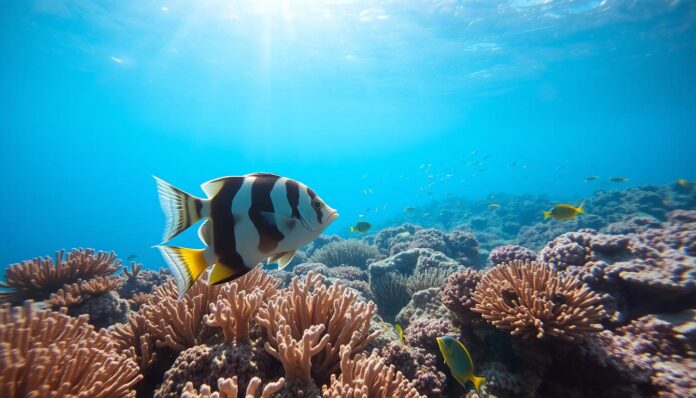Did you know that about 70% of the time, divers get chased by titan triggerfish? Scuba diving with these fish needs careful planning and respect. Knowing how they act is key to exploring coral reefs safely.
Triggerfish are known for being very protective, even more so during mating season. Their bites can be very strong, up to 400 psi. This can damage your diving gear and even hurt you if you enter their space by mistake.
This guide will teach you all about triggerfish behavior. You’ll learn how to stay safe while diving. You’ll know how to spot danger signs and protect yourself underwater.
Key Takeaways – Diving with Triggerfish
- Triggerfish become extremely territorial during mating season
- 90% of triggerfish bites are non-life-threatening but can cause injuries
- Maintain at least 3 meters distance from nesting areas
- Swim horizontally when exiting triggerfish territory
- Understanding fish behavior is key to safe diving
Understanding Triggerfish Behavior
Encountering triggerfish underwater can be thrilling and tricky for photographers. These interesting fish live in warm oceans, with about 40 types in the Balistidae family. The Indo-Pacific area has the most variety of these fish.
Common Species of Triggerfish
While diving, you might see several unique triggerfish species. The most famous ones are:
- Titan triggerfish (Balistoides viridescens): Growing up to 75 centimeters long
- Orange striped triggerfish (Balistapus undulatus): With an estimated lifespan of 10 years
- Diverse species inhabiting depths up to 50 meters
Triggerfish Territoriality
Territorial behavior defines triggerfish interactions. They are very protective during breeding season. They make a cone-shaped territory around their nests. Divers need to be careful when getting close to these areas to avoid trouble.
Signs of Aggression in Triggerfish
“Understanding triggerfish behavior is key to safe and respectful marine life encounters.” – Marine Biology Research Institute
Triggerfish can get aggressive when they feel threatened. Look out for these signs of aggression:
- Rapid swimming movements toward divers
- Positioning directly facing the perceived threat
- Repeated charging or nudging behaviors
Even though triggerfish bites aren’t venomous, they can hurt a lot. Photographers should keep a safe distance and watch these fish from afar.
Preparing for Your Dive
Scuba diving needs careful preparation for a safe and fun underwater adventure. Whether you’re new or experienced, knowing the right gear and pre-dive steps is key. It ensures a successful dive.
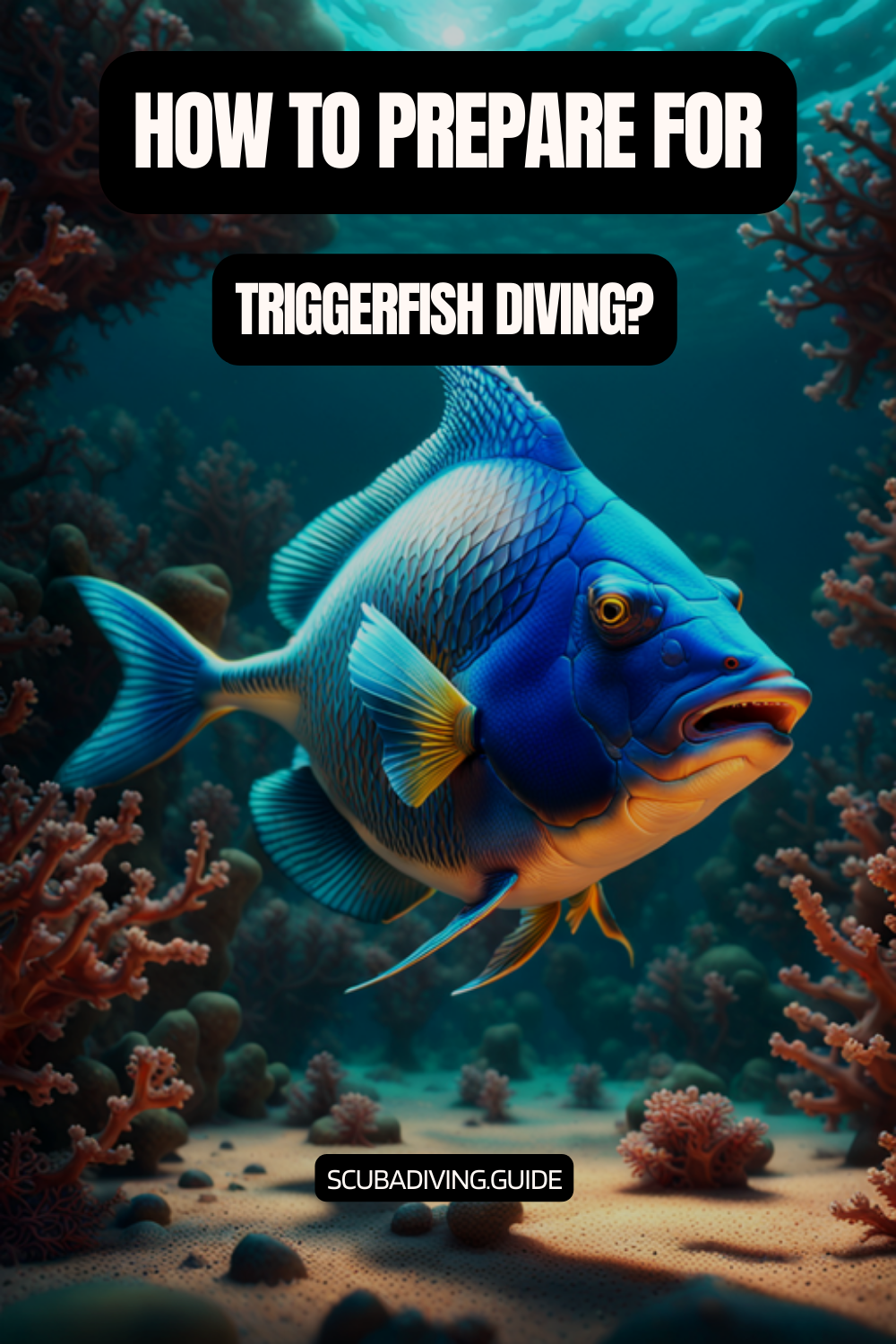
Essential Gear for Scuba Diving
Choosing the right dive gear is vital for your safety and comfort. Many dive centers offer gear rentals, making it easy to get top-notch equipment. Important items include:
- Mask and snorkel
- Wetsuit or drysuit
- Fins
- Buoyancy Control Device (BCD)
- Regulator and oxygen tank
- Weight belt
“Proper equipment is your first line of defense in underwater exploration.” – Professional Diving Instructor
Pre-Dive Briefing Fundamentals
Before diving, a detailed pre-dive briefing is a must. PADI courses stress the importance of these meetings. Dive masters will cover:
- Dive site characteristics
- Potential marine life encounters
- Emergency communication signals
- Oxygen management techniques
- Buddy system protocols
Experts say getting PADI certification is a must for underwater skills. These courses take four to seven days. They prepare you for different diving situations.
Remember, preparation is key to a safe and memorable diving experience!
Safety First: Avoiding Triggerfish Encounters
Diving in the ocean needs careful attention, mainly around triggerfish. These territorial fish require respect and understanding. This ensures a safe and fun snorkeling tour.
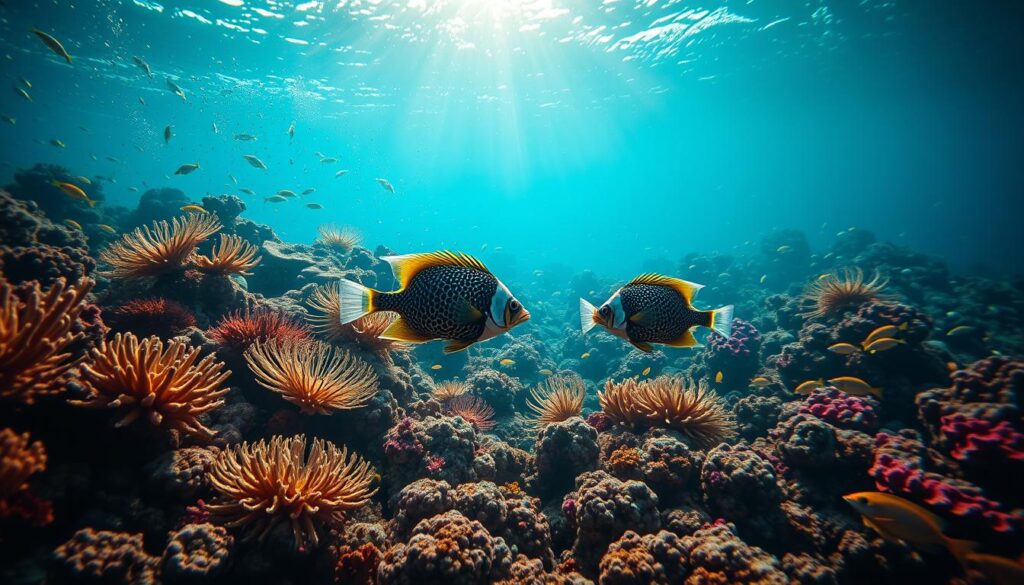
Triggerfish are known for being aggressive, mostly during nesting times. Knowing their homes and keeping a safe distance is key. This is important for divers and those helping with marine conservation.
Recognizing Triggerfish Habitats
Triggerfish live in shallow waters near coral reefs. Their territories can be quite big, covering about 3 meters around their nests.
- Shallow coral reef environments
- Areas with dense marine vegetation
- Regions with abundant small marine life
Keeping a Safe Distance
It’s important to keep a safe distance from triggerfish. Experts say to stay at least 5 meters away from their nests to avoid aggressive behavior.
| Encounter Risk | Recommended Action |
|---|---|
| Entering Nesting Territory | Retreat slowly, avoid sudden movements |
| Perceived Threat | Use fins as a protective barrier |
| Direct Confrontation | Maintain calm, do not engage |
About 50% of divers in Southeast Asia face aggressive titan triggerfish during nesting season. Knowing their behavior and respecting their space can lower the risk of trouble.
The key to safe diving is not just skill, but respect for marine ecosystems and their inhabitants.
Always listen to your snorkeling tour guide and focus on safety and marine conservation. Remember, diving responsibly protects both people and the ocean’s delicate balance.
What to Do if You Encounter Triggerfish
Scuba diving with Triggerfish needs knowledge and calm. Marine life can be unpredictable, like with territorial Titan Triggerfish.
Knowing how triggerfish behave is key for safe underwater meetings. About 80% of times with nesting titan triggerfish can turn aggressive. So, knowing how to react is very important.
Staying Calm and Assessed
When an aggressive triggerfish comes your way, stay calm. Panic can make things worse and make the fish more defensive.
- Keep eye contact with the triggerfish
- Move slowly and deliberately
- Avoid direct, vertical movements
- Use diving gear as a protective barrier
Techniques for Managing Aggressive Triggerfish
Experienced divers suggest certain ways to handle triggerfish:
- Use fins as a protective shield
- Swim horizontally away from the territory
- Maintain a consistent, steady pace
- Exit the area without sudden movements
“90% of divers successfully evade aggressive titan triggerfish by using proper fin protection techniques.”
Understanding triggerfish behavior makes scary encounters interesting. It turns scuba diving into an exciting underwater adventure.
The Importance of Dive Education
Diving into the underwater world is more than just fun. It needs professional education to become a responsible explorer. PADI certification courses teach the essential knowledge for safe and respectful diving.
Knowing marine ecosystems is key for every diver. Education is the first step in conservation. It teaches divers how to interact gently with the underwater world.
Certification Programs for Beginners
Beginners have many certification options:
- Open Water Diver Course
- Scuba Diver Certification
- Advanced Open Water Diver Program
“Education is the most powerful weapon for marine conservation” – Marine Biologist
Workshops on Marine Species Awareness
Special workshops offer deep insights into marine life. They teach divers important skills like:
- Identifying marine species behaviors
- Understanding territorial boundaries
- Practicing non-invasive observation
Professional training makes divers guardians of our ocean ecosystems.
Choosing the Right Dive Site
Planning a coral reef exploration needs careful thought and the right dive spot. For those who love triggerfish, knowing the best places can make a dive unforgettable.
Liveaboard adventures are great for finding remote triggerfish homes. The Indo-Pacific area has some amazing spots for these creatures.
Popular Locations for Triggerfish Encounters
Asia:
- Maldives: Known for its stunning coral reefs and abundant marine life, the Maldives is a haven for divers seeking encounters with triggerfish. The crystal-clear waters and diverse ecosystems make it an ideal destination for observing these captivating creatures.
- Indonesia: With its vast archipelago and renowned dive sites like Raja Ampat, Komodo National Park, and Bali, Indonesia offers a wide range of diving opportunities. Triggerfish can be spotted in these vibrant waters, showcasing their unique behaviors and colors.
- Philippines: The Philippines boasts an incredible diversity of marine life, including triggerfish. Destinations like Tubbataha Reefs Natural Park, Apo Island, and Anilao are known for their healthy coral reefs and abundant marine biodiversity, making them excellent choices for encountering triggerfish.
- Egypt: The Red Sea, with its crystal-clear waters and vibrant coral reefs, is a prime destination for diving with triggerfish. Popular dive spots like Dahab, Sharm El Sheikh, and Hurghada offer exceptional opportunities to explore triggerfish habitats and witness their captivating behaviors.
- Seychelles: The Seychelles archipelago is home to an abundance of marine life, including triggerfish. Divers can explore stunning coral reefs and encounter triggerfish in locations like Aldabra Atoll, Cousin Island, and Sainte Anne Marine National Park.
- Bonaire: Known for its pristine marine environment, Bonaire offers excellent diving conditions and abundant marine life. The island’s Marine Park is a sanctuary for triggerfish, where divers can enjoy up-close encounters with these fascinating creatures.
- Cayman Islands: With their world-renowned dive sites, the Cayman Islands are a top choice for divers seeking triggerfish encounters. Dive locations like Bloody Bay Wall in Little Cayman and the USS Kittiwake wreck in Grand Cayman provide opportunities to observe triggerfish in their natural habitats.
- Belize: The Belize Barrier Reef, a UNESCO World Heritage site, is a remarkable destination for diving with triggerfish. With its diverse marine ecosystems and famous sites like the Blue Hole and Glover’s Reef Atoll, Belize offers thrilling encounters with triggerfish and other marine species.
- Costa Rica: Costa Rica’s Pacific and Caribbean coasts offer diverse diving experiences. Destinations like Cocos Island, Bat Islands, and Cano Island are known for their encounters with triggerfish and other pelagic species, making them popular choices for adventurous divers.
- Red Sea Coast, Egypt: The Egyptian Red Sea Coast, with its vibrant reefs and abundant marine life, is a favorite destination for European divers. Cities like Hurghada and Marsa Alam provide access to exceptional diving sites where triggerfish can be observed.
- Great Barrier Reef, Australia: The Great Barrier Reef is a world-renowned diving destination, offering an awe-inspiring underwater experience. Alongside the vibrant coral formations, divers can encounter triggerfish and a vast array of marine species in this UNESCO World Heritage site.
- Fiji: The crystal-clear waters of Fiji’s islands are teeming with marine life, including triggerfish. Dive sites like the Somosomo Strait and the Great Astrolabe Reef provide opportunities to witness the beauty and diversity of triggerfish in this tropical paradise.
- Florida Keys, USA: The Florida Keys offer diverse diving opportunities, with vibrant coral reefs and a rich underwater ecosystem. Divers can explore sites like Looe Key and the Christ of the Abyss statue, where triggerfish can be spotted alongside other fascinating marine species.
- Galapagos Islands, Ecuador: The Galapagos Islands are a bucket-list destination for divers. Famous for its unique biodiversity, this archipelago provides opportunities to encounter triggerfish, sea turtles, sharks, and other endemic species in their natural habitats.
- Fernando de Noronha, Brazil: This Brazilian archipelago is a UNESCO World Heritage site and a marine protected area. Divers visiting Fernando de Noronha can explore its crystal-clear waters and observe triggerfish, dolphins, and an array of marine life.
Please note that the presence and sightings of triggerfish may vary depending on the specific dive sites and seasons in these regions. It’s always recommended to consult with local dive operators or experienced divers to gather the most up-to-date information and guidance.
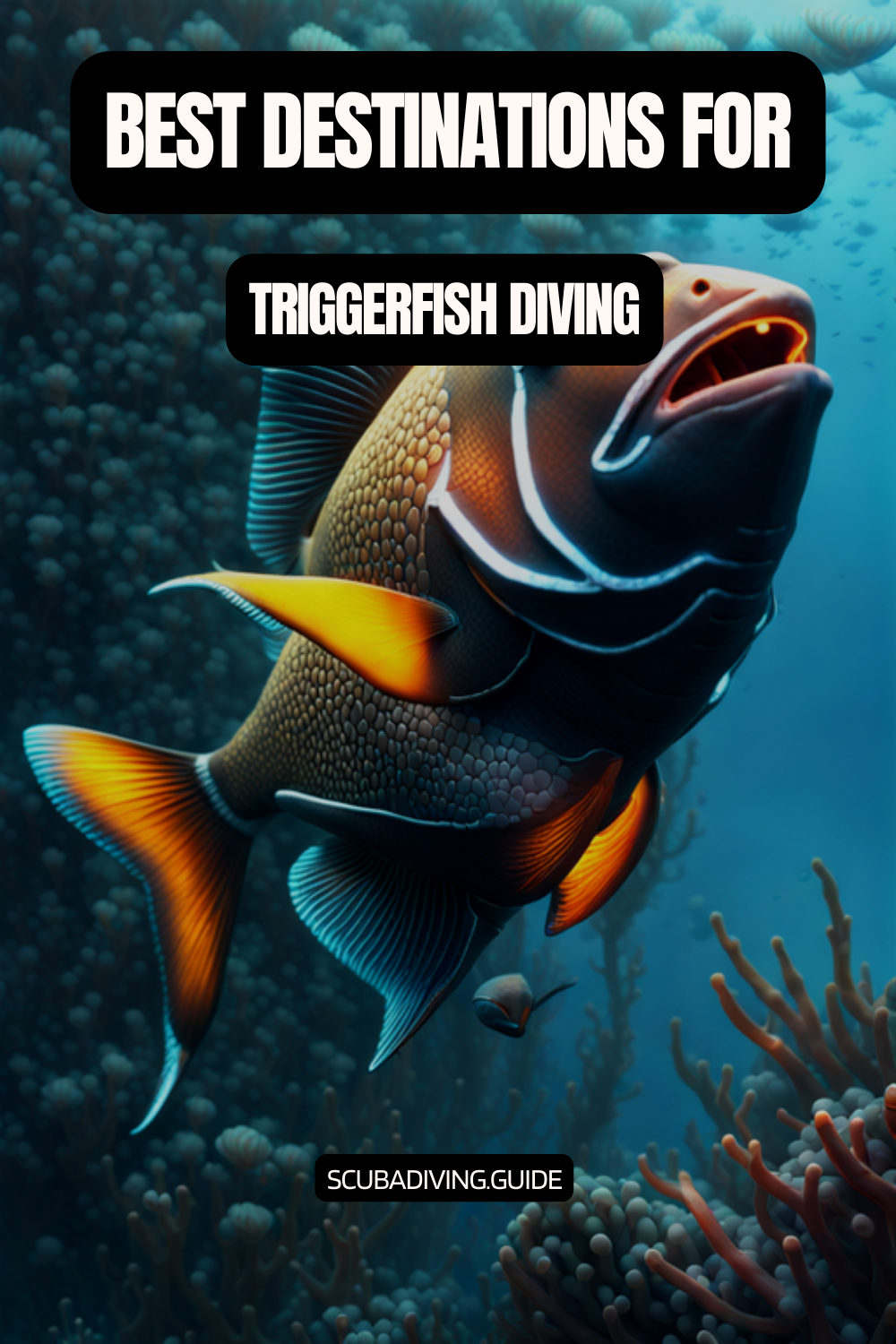
Guidelines for Selecting a Dive Operator
Finding a good dive operator is key for a safe and fun dive. Look for ones with:
- Certified marine guides
- Comprehensive safety protocols
- Extensive knowledge of local triggerfish behavior
- Well-maintained diving equipment
“The right dive operator can transform your underwater journey from ordinary to extraordinary.”
When planning your dive, pick dive centers that offer special training. Dive packages from 5 to 10 days can give you a deep dive into triggerfish habitats.
Environmental Considerations
Triggerfish are key to keeping coral reefs healthy. They help keep the balance in these underwater worlds. Their actions are vital for the health of our oceans.
The Role of Triggerfish in Ecosystems
When we explore coral reefs, we see triggerfish at work. They are important predators. They help control the numbers of smaller sea creatures.
Their eating habits are good for the reef. They:
- Keep algae from growing too much
- Manage the numbers of invertebrates
- Help keep the reef in balance
Protecting Triggerfish Habitats
We must protect triggerfish and their homes. Clown triggerfish live in the Indo-West Pacific. Their range goes from South Africa to the central Pacific Ocean.
“Protecting marine habitats is not just about preserving individual species, but maintaining entire ecological systems.”
| Triggerfish Habitat Characteristics | Conservation Significance |
|---|---|
| Depth Range | Shallow to 75 meters |
| Average Size | 6-50 cm |
| Primary Threat | Marine Aquarium Trade |
By diving responsibly, we help protect triggerfish. We can reduce harm to the environment. And we can learn more about these amazing sea creatures.
Health and Safety Precautions
Scuba diving with Triggerfish needs careful planning and knowing health risks. Safety is the most important thing when diving. Knowing the right precautions can make your dive safe and fun.
Dealing with Allergies and Marine Stings
Many dive gear rentals come with protective gear to avoid marine stings. Here are some health tips for diving with triggerfish:
- Wear a full-body wetsuit to protect against stings
- Carry a marine first-aid kit for underwater injuries
- Learn how to treat marine animal encounters
“Preparation is the key to safe diving” – Professional Diving Association
Signaling for Help Underwater
Good communication is key when diving with Triggerfish. Divers should learn how to signal for help underwater.
- Learn standard international diving hand signals
- Practice emergency communication with your dive buddy
- Carry an emergency signaling device like a whistle or surface marker buoy
Important safety stats show why being prepared is vital: Diving fatalities occur at a rate of 16.4 per 100,000 divers.
Air Management and Safety Checks
Managing air properly is key for safe diving. Keep these tips in mind:
- Maintain at least 50 bar of air upon surfacing
- Follow the 1/3 air allocation rule: 1/3 out, 1/3 back, 1/3 safety
- Check air gauge frequency based on dive depth
Responsible Diving Practices
Scuba diving lets us see the beauty of marine life up close. But, we must remember our big responsibility to protect these underwater worlds. Conservation efforts are key to keeping marine life safe for the future.
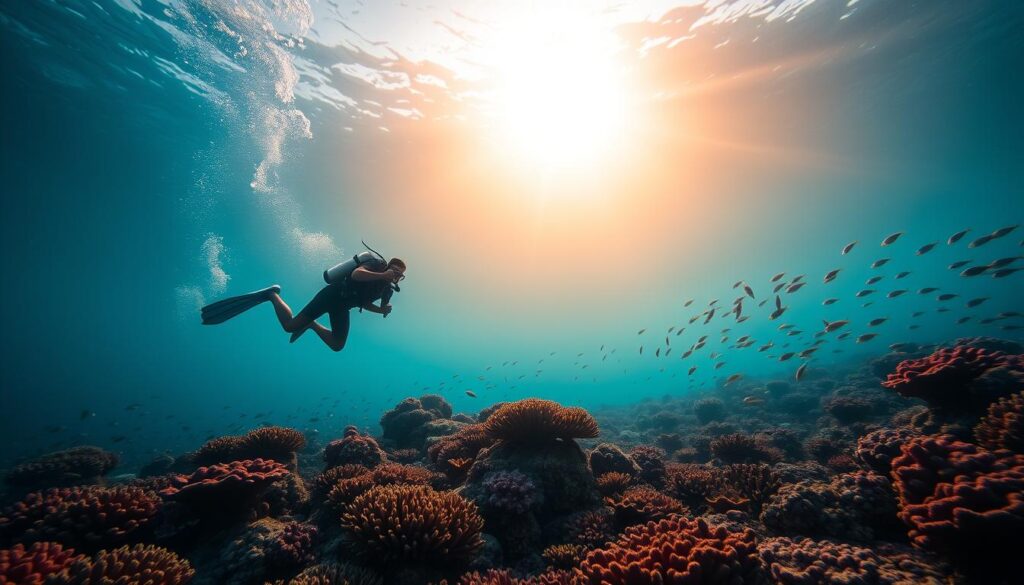
Divers can greatly help by diving mindfully. PADI courses teach us to leave a small environmental footprint. They also show us how to respect the marine habitats we explore.
Minimizing Your Underwater Footprint
Responsible divers follow important rules to protect the sea:
- Maintain proper buoyancy control to avoid damaging coral reefs
- Never touch or disturb marine life
- Use reef-safe sunscreen to prevent chemical contamination
- Avoid creating underwater disturbances
Respecting Marine Life
Knowing about marine ecosystems is vital for their protection. PADI courses teach divers how to interact with the sea responsibly.
“Every dive is an opportunity to be an ambassador for ocean conservation.” – Marine Conservation Expert
By diving responsibly, we help protect our oceans. The IUCN says 80% of ocean trash is plastic. So, our actions are very important for keeping our oceans clean.
- Participate in marine cleanup initiatives
- Support local conservation programs
- Educate others about marine preservation
Remember, diving responsibly is not just about staying safe—it’s about protecting our planet’s most precious underwater places.
Enjoying the Experience
Diving with triggerfish is a great chance to take amazing underwater photos. Use wide-angle lenses and learn about their behaviors. This will make your photos even better.
Night dives are special for seeing triggerfish up close. Use the right camera settings to capture them safely. Redang Island is perfect for taking stunning photos of triggerfish.
Photography Tips for Capturing Triggerfish
Choose cameras that work well in low light. Use strobe lights to highlight their features without harming them. Be patient and wait for the best moments to capture.
Sharing Your Dive Stories and Experiences
Use diving forums and social media to share your adventures. It keeps your memories alive and teaches others about marine life. Always respect the ocean and dive responsibly.
Common Marine Species Found Alongside Triggerfish
Diving with triggerfish provides an opportunity to encounter not only these fascinating creatures but also a diverse array of marine life that share their habitats. Here are some common marine species you may encounter alongside triggerfish during your dives:
- Clownfish (Family: Pomacentridae): Clownfish, also known as anemonefish, are often found in close proximity to triggerfish. These small and colorful fish form symbiotic relationships with sea anemones, seeking shelter among their tentacles. Observing the playful interactions between clownfish and triggerfish can be a delightful experience.
- Moray Eels (Family: Muraenidae): Moray eels are commonly found in coral reefs and rocky areas where triggerfish reside. These elongated and secretive creatures can often be spotted peering out from crevices or swimming through the reef. Moray eels come in various colors and patterns, adding to the visual diversity of the underwater landscape.
- Butterflyfish (Family: Chaetodontidae): Butterflyfish are known for their vibrant colors and striking patterns, making them a visual delight during dives. These small, flat-bodied fish are often found in pairs or small groups. Their graceful movements and intricate markings complement the beauty of triggerfish encounters.
- Parrotfish (Family: Scaridae): Parrotfish are renowned for their vibrant colors and prominent beaks. These herbivorous fish play a crucial role in maintaining the health of coral reefs through their feeding habits. Diving alongside parrotfish can offer a glimpse into their feeding behavior as they scrape algae off coral surfaces.
- Surgeonfish (Family: Acanthuridae): Surgeonfish, also known as tangs, are characterized by the sharp spines or “scalpels” on their sides. These fish often form schools and display impressive maneuverability. Their vibrant colors and distinctive shape make them a common sight alongside triggerfish on coral reefs.
- Angelfish (Family: Pomacanthidae): Angelfish are known for their striking colors and disk-like bodies. These graceful swimmers can often be found hovering near coral formations or gliding through the water column. Encountering angelfish alongside triggerfish adds a touch of elegance to your dive experience.
- Damselfish (Family: Pomacentridae): Damselfish are small, territorial fish commonly seen in shallow reef environments. They come in a variety of colors and are known for their aggressive behavior when defending their territory. Diving with triggerfish provides an opportunity to witness their interactions and the unique dynamics within damselfish communities.
- Various Invertebrates: Alongside triggerfish, you may also encounter a variety of invertebrates such as sea cucumbers, sea stars, lobsters, and colorful reef crustaceans. These fascinating creatures add diversity and texture to the underwater landscape, creating a vibrant and dynamic ecosystem.
Remember to approach and observe these marine species responsibly, ensuring you do not disturb their natural behaviors or habitats. Appreciating the interconnectedness of these species alongside triggerfish enhances the overall richness of your dive experiences.
FAQ – Diving with Triggerfish
What species of triggerfish are most commonly encountered by divers?
Divers often meet the titan triggerfish. They also see blue and Picasso triggerfish in warm waters. Each type has its own way of acting and defending its space.
How dangerous are triggerfish during nesting season?
Triggerfish, like titan triggerfish, get very protective when nesting. They might attack divers who get too close. Keep at least 15-20 feet away and be ready to defend yourself if needed.
What gear can help protect against triggerfish encounters?
You’ll need strong fins, a good mask, and maybe a clipboard or fins for defense. Full-length wetsuits help too. Dive shops suggest special gear for tough marine spots.
How should I react if a triggerfish becomes aggressive?
Stay calm and don’t panic. Swim away horizontally, using your fins for protection. Keep eye contact and move slowly. Avoid swimming up, as it looks like a threat.
Are triggerfish encounters more common during specific times of the year?
Yes, during breeding season, from September to November, they’re more aggressive. Dive operators can tell you when it’s best to dive in your area.
What PADI certifications are recommended for diving in triggerfish habitats?
Get the PADI Advanced Open Water Diver certification for coral reefs. The PADI Marine Life Awareness Specialty teaches about marine life and how to interact with it.
Can I photograph triggerfish safely?
Yes, but keep a safe distance and use a zoom lens. Wide-angle cameras are best for their behavior. Always put your safety first and be ready to leave if they get aggressive.
What marine conservation efforts involve triggerfish research?
Research groups study triggerfish to understand their role in reefs. They look at breeding, territory, and reef health. Divers can help by joining citizen science and supporting conservation.
Are triggerfish encounters different during night dives?
Night dives offer unique experiences with triggerfish. They’re less territorial but curious. Use strong lights and move slowly to avoid scaring them.
How can I prepare for possible triggerfish interactions during a dive?
Take marine life courses, research local species, and attend dive briefings. Practice calm underwater communication. Dive operators offer workshops on safety and species interaction.
